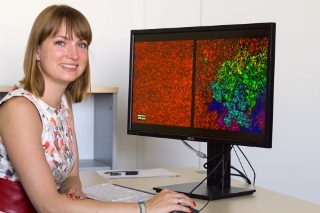Aug 3 2015
A team of researchers headed by Prof. Silke Christiansen from the Institute of Nanoarchitectures for Energy Conversion at Helmholtz-Zentrum Berlin (HZB) has created a novel transparent electrode capable of high electrical conductivity for solar cells and other optoelectronic components with limited material. The electrode is made up of an irregular network of silver nanowires coated with aluminium-doped zinc oxide.
 Manuela Göbelt is evaluating SEM-images to calculate the local degree of networking. Photo: Björn Hoffmann.
Manuela Göbelt is evaluating SEM-images to calculate the local degree of networking. Photo: Björn Hoffmann.
Nearly 70 times less silver compared to the traditional silver grid electrodes is required for the newly created electrode. However, it can match the same levels of electrical conductivity as the traditional one.
Basically, electrodes that need to be connected on the “sunny side” of a solar cell have to be electrically conductive as well as transparent. Hence, the currently available electrodes are manufactured by using a transparent electrically conductive indium tin oxide (ITO) compound layer, or by using thin silver strips in the form of a coarse-meshed grid squeegeed onto a surface. However both these options are not the most suitable, as silver is quite expensive and nano silver particles tend to oxidize very swiftly. Similarly, indium is a highly rare element on earth crust at least for near future.
Mesh of silver nanowires
Manuela Göbelt, a doctoral student in the team of Prof. Silke Christiansen has created a smart new solution using just a fraction of the silver and without using any indium to assemble a technologically innovative electrode.
At first Göbelt suspended the silver nanowires in ethanol using wet-chemistry methods. Using a pipette, she moved this suspension onto a substrate i.e. silicon solar cell. When the solvent begins to evaporate, the silver nanowires start assembling into a loose transparent mesh and still retaining the dense nature so as to form continuous current paths.
Encapsulation by AZO crystals
Göbelt used an atomic layer deposition method to slowly apply a coating of a highly doped wide bandgap semiconductor referred to as AZO. AZO is basically zinc oxide that is doped with aluminium. This material is not as expensive as the ITO but equally transparent however, not as electrically conductive.
During the process, minute AZO crystals form on silver nanowires completely covering them. They fill even the interstices. The silver nanowires measure around 120nm in diameter, and are encased in a layer of AZO measuring around 100nm.
Quality map calculated
When the newly developed composite electrode was measured for electrical conductivity, it matched that of the traditional silver grid electrode. The performance would depend upon the interconnectivity of the nanowires. This would in turn depend on the lengths of the wires and the concentration of silver nanowires in the suspension.
With the aid of computers, the researchers could pinpoint the degree of networking ahead of time. They analyzed images captured using a scanning electron microscope and estimated electrical conductivity of the electrodes from them using advanced image analysis algorithms.
“We are investigating where a given continuous conductive path of nanowires is interrupted to see where the network is not yet optimum”, explains Ralf Keding. It took almost five days even with high-performance computers to compute an excellent quality map of the electrode. Now the team is working on enhancing the software so as to decrease the computation time.
“The image analysis has given us valuable clues about where we need to concentrate our efforts to increase the performance of the electrode, such as increased networking to improve areas of poor coverage by changing the wire lengths or the wire concentration in solution”, says Göbelt.
Practical alternative to conventional electrodes
"We have developed a practical, cost-effective alternative to conventional screen-printed grid electrodes and to the common ITO type that is threatened however by material bottlenecks”, says Christiansen, who heads the Institute of Nanoarchitectures for Energy Conversion at HZB and additionally directs a project team at the Max Planck Institute for the Science of Light (MPL).
Only a fraction of silver, nearly no shadow effects
Thus the newly created electrodes contained only 0.3g of silver per square meter compared against the traditional one which used between 15 and 20g of silver. Furthermore, the new electrode only casts a smaller shadow on the solar cell.
“The network of silver nanowires is so fine that almost no light for solar energy conversion is lost in the cell due to the shadow”, explains Göbelt. On the contrary, she hopes “it might even be possible for the silver nanowires to scatter light into the solar cell absorbers in a controlled fashion through what are known as plasmonic effects.”